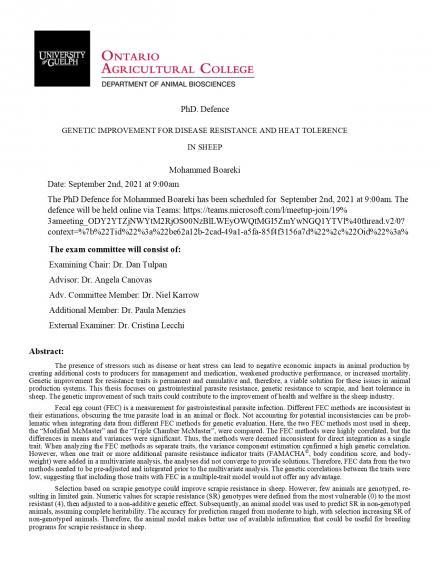Mohammed Boareki's PhD Defence
Date and Time
Location
Teams: https://teams.microsoft.com/l/meetup-join/19%3ameeting_ODY2YTZjNWYtM2RjOS00NzBlLWEyOWQtMGI5ZmYwNGQ1YTVl%40thread.v2/0?context=%7b%22Tid%22%3a%22be62a12b-2cad-49a1-a5fa-85f4f3156a7d%22%2c%22Oid%22%3a%22fbd28915-dda5-478f-8ecb-a3682dcf0c3a%22%7d

Details
The presence of stressors such as disease or heat stress can lead to negative economic impacts in animal production by creating additional costs to producers for management and medication, weakened productive performance, or increased mortality. Genetic improvement for resistance traits is permanent and cumulative and, therefore, a viable solution for these issues in animal production systems. This thesis focuses on gastrointestinal parasite resistance, genetic resistance to scrapie, and heat tolerance in sheep. The genetic improvement of such traits could contribute to the improvement of health and welfare in the sheep industry.
Fecal egg count (FEC) is a measurement for gastrointestinal parasite infection. Different FEC methods are inconsistent in their estimations, obscuring the true parasite load in an animal or flock. Not accounting for potential inconsistencies can be prob-lematic when integrating data from different FEC methods for genetic evaluation. Here, the two FEC methods most used in sheep, the “Modified McMaster” and the “Triple Chamber McMaster”, were compared. The FEC methods were highly correlated, but the differences in means and variances were significant. Thus, the methods were deemed inconsistent for direct integration as a single trait. When analyzing the FEC methods as separate traits, the variance component estimation confirmed a high genetic correlation. However, when one trait or more additional parasite resistance indicator traits (FAMACHA©, body condition score, and body-weight) were added in a multivariate analysis, the analyses did not converge to provide solutions. Therefore, FEC data from the two methods needed to be pre-adjusted and integrated prior to the multivariate analysis. The genetic correlations between the traits were low, suggesting that including those traits with FEC in a multiple-trait model would not offer any advantage.
Selection based on scrapie genotype could improve scrapie resistance in sheep. However, few animals are genotyped, re-sulting in limited gain. Numeric values for scrapie resistance (SR) genotypes were defined from the most vulnerable (0) to the most resistant (4), then adjusted to a non-additive genetic effect. Subsequently, an animal model was used to predict SR in non-genotyped animals, assuming complete heritability. The accuracy for prediction ranged from moderate to high, with selection increasing SR of non-genotyped animals. Therefore, the animal model makes better use of available information that could be useful for breeding programs for scrapie resistance in sheep.
Heat stress can negatively affect the growth performance of lambs. Heat stress thresholds for Temperature-Humidity Index (THI), at which points the bodyweight begins to decline, were determined for weaning weight and post-weaning gain in lambs. Heat stress functions, modeling THI beyond the threshold, were used as the environmental gradient for heat stress to examine possible genotype by environment interaction, using a reaction norm model. The results confirmed genetic antagonism between growth traits and heat tolerance. Hence, this antagonism needs to be accounted for in potential breeding programs. Variation in heritability esti-mates across the heat stress gradient provides opportunity for selection for growth traits within specific environments.